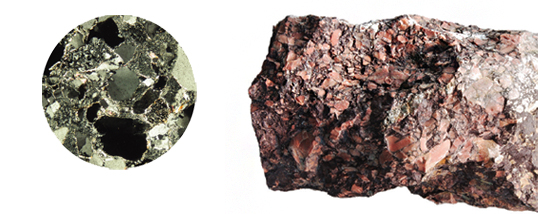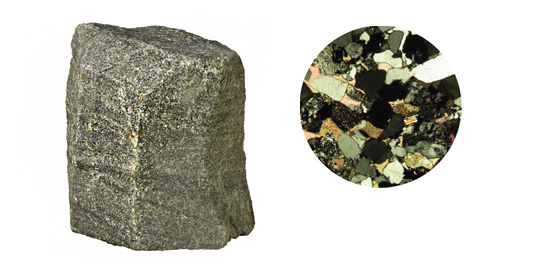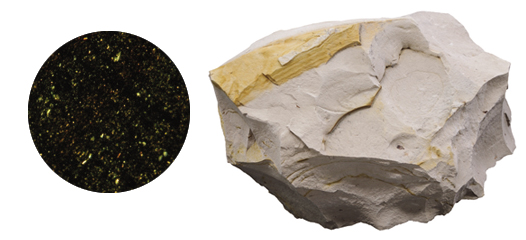Sedimentary Rocks
Sedimentary rocks are composed mainly of small particles (sediments) derived by the weathering and erosion of pre-existing rocks at the Earth’s surface, subsequently transported and deposited by water, wind or glaciers. Sedimentary rocks commonly preserve the history of the geologic environment and biological world at the time of deposition. Sedimentary rocks are grouped into clastic, chemical and organic sedimentary rocks based on how they form.

Lapilli TuffMokpo, Korea
A pyroclastic rock consisting of lapilli (2-64 mm in size) and volcanic ash.
Clastic Sedimentary Rocks Clastic sedimentary rocks form by weathering processes which break down rocks into pebble, sand, or clay particles by exposure to wind, ice, and water. Clastic sedimentary rocks are commonly classified according to the grain size and shape of the sediment particles, including conglomerate, breccia, sandstone, siltstone, mudstone and shale. In some cases, clastic sedimentary rocks are named according to their depositional environment and mode of deposition. Examples include eolian sandstone, tuff, agglomerate, tillite and varved clay.
Chemical Sedimentary Rocks Chemical sedimentary rocks consist of materials formed by a chemical process such as precipitation from solution or evaporation. Chemical sedimentary rocks include dolomite, gypsum, rock salt, chert, bedded ironstone and tufa.
Organic Sedimentary Rocks Organic sedimentary rocks are made up mainly of the remains of organisms (plants and animals), which are broken into fine fragments. Limestone, chalk, diatomite, chert and coal are important organic sedimentary rocks.

Organic Sedimentary Rock - DiatomiteGyeongju, Korea
Diatomite consists of fossils of planktonic diatoms having siliceous shells.

Chemical Sedimentary Rock - EvaporiteMexico
This evaporite consists mainly of gypsum, precipitated by evaporation of saline water. Gypsum contains sulfate (SO4) ion, being commonly used as a fertilizer.

Conglomerate Yeongdong, Korea
Conglomerate consists of rounded gravels, rock fragments and mineral grains with matrices of sands and clays.

Breccia Mungyeong, Korea
Breccia consists of angular rock fragments with interstitial matrices of sands and clays.

Sandstone Yeosu, Korea
Sandstone consists mainly of sand grains (quartz, feldspar and rock fragment).

Mudstone Pohang, Korea
Mudstone consists dominantly of clays with minor silts. Mudstone makes up about 50 % of the sedimentary rocks.